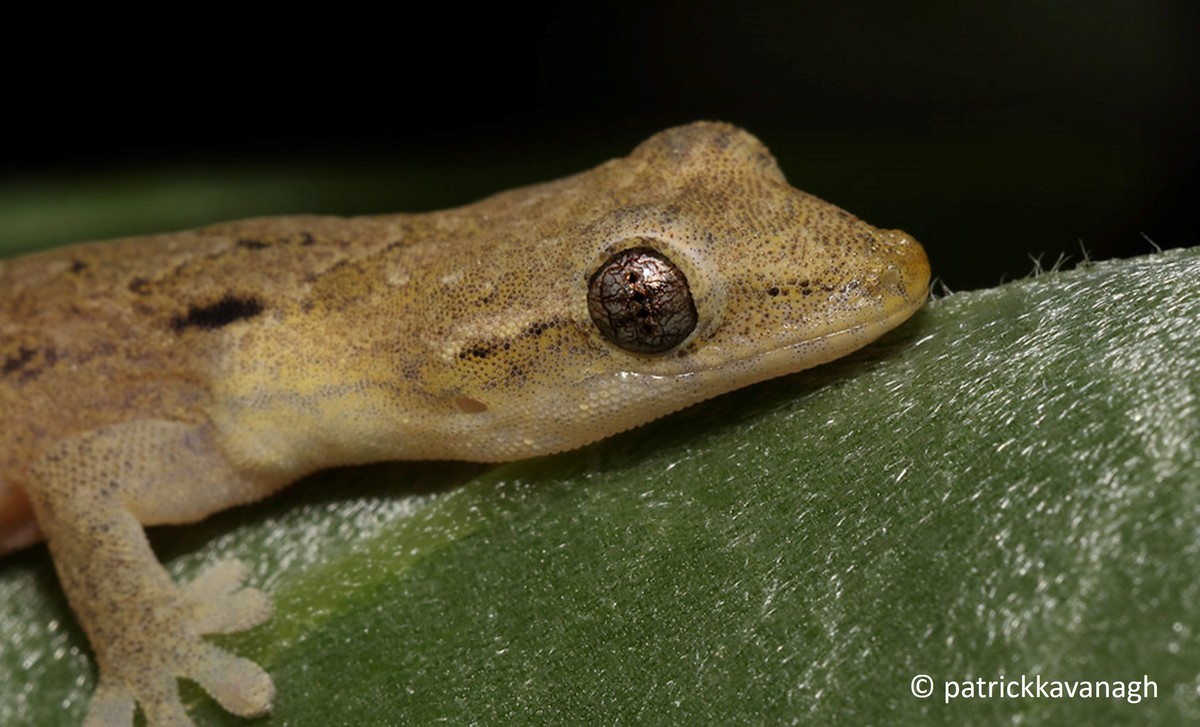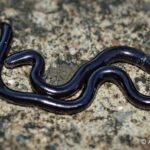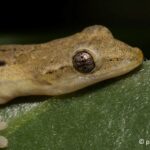
- Nom vernaculaire: Gecko nain, Le Gecko demi-deuil
- Nom scientifique : Lepidodactylus lugubris (Duméril & Bibron, 1836)
- Nom local: Mourning gecko, Common Smooth-scaled gecko
- Ordre : Gekkonidae
- Famille : Squamata
Description
Morphologie. Le gecko nain est un gecko de petite taille, de couleur claire, qui se caractérise par la présence de griffes sur quatre doigts sur cinq (le pouce en est dépourvu), un corps d’aspect lisse, sans tubercules, avec un motif dorsal à base de taches noires symétriques, parfois discrètes, en forme de « V », de « W » ou sous forme de points. La base de la queue est légèrement élargie (HerpMe, Société Herpétologique de France).
Taille corporelle standard (longueur tête-tronc). 33 à 48 mm (Ineich et Ota, 1993; Hoogmoed et Avila-pires, 2015; Sakai, 2016).
Dimorphisme sexuel. Pas de dimorphisme sexuel marqué. Les mâles présentent deux hemipenis, des pores fémoraux, et des testicules externes (Brown et Murphy-Walker, 1996; Saiko et Ota, 1998; Röll et Düring, 2008).
Variations. La couleur du corps d’un même individu peut varier du clair au sombre, selon son état. Aucune variation phénotypique régionale n’est observée.
Confusion possible avec d’autres espèces. Dans les petites Antilles, la confusion est possible avec une autre espèce exotique de gecko, l’Hémidactyle commun (ou gecko des maisons, ou encore mabouya domestique) Hemidactylus mabouia. Cependant, l’hémidactyle commun se distingue par la présence de cinq griffes sur chaque patte (une par doigt), un corps couvert de tubercules, et six rangées longitudinales de tubercules épineux sur la queue (HerpMe, Société Herpétologique de France).
Distribution
Native. Asie: Taiwan, Chine, Archipel des Chagos, Sri Lanka, Inde (et îles Adaman), Seychelles, Myanmar, Ouest-Malaisie (Pulau Pinang, Pulau Tioman), Vietnam, Japon (Ryukyu, Bonin, Ogasawara, Okinawa, Miyako, Yaeyama et Daito), Indonesie (Borneo, Lombok, Sulawesi, Halmahera, Ambon, Kei, Komodo, Flores, Morotai), Philippines (Panay, Luzon, Cebu), Palau, Nouvelle Guinée, Archipel Bismarck, Nauru, îles Salomon, Micronesie (Lukunor Atoll), Fiji, Rotuma, Nouvelle Calédonie, îles Loyauté, Vanuatu, Toga, Tegua, Hiu, îles Mariannes (Hileman et al., 2020), îles de Cook (Roratonga), Tonga, Australie, îles Maldive, Samoa de l’Ouest, Guam, archipel de la Société, Mascareignes (Rodrigues) (Nania et al., 2020).
Introduit. Hawaï, Floride (Hoomgoed et Avila-Pires, 2015), Mexique (Ahumada-Carillo et Weatherman, 2018), Nicaragua (Sunyer et al., 2013), Costa-Rica, Panama, Brésil, Équateur (dont Galapagos), Colombie (dont San Andres, Providencia, Islas del Rosario, Bolivar) (Hoomgoed et Avila-Pires, 2015; Señaris et al., 2017), Chili (Urra et al., 2020), Suriname, Venezuela (Señaris et al., 2017).
Caraïbes: Bahamas (Paradise Island) (Krysko and MacKenzie-Krysko 2016; Liebgold et al., 2019), Cuba (Bosch et Paez, 2017), Iles Caymans (Goetz and Burton 2018), Iles Turques-et-Caïques (Ruhe et Ruhe, 2019), Guadeloupe (Basse Terre et Grande Terre) (Lorvelec et al., 2017; Borroto-Paez, 2018), Trinidad et Tobago (Auguste et Fifi, 2020), Curaçao (Behm et al., 2019).
Biologie et écologie
Habitat. La distribution globale de l’espèce reflète sa préférence pour un climat tropical à sub-tropical. Le gecko nain est capable d’évoluer dans une grande diversité d’habitats naturels et anthropisés. On le retrouve ainsi au sein des de mangroves et d’environnements côtiers, dans les forêts humides, mais également dans les zones urbaines et péri-urbaines où les éclairages artificiels offrent une source de nourriture facilement accessible et abondante (Hoogmoed et Avila-Pires, 2015).
Régime alimentaire. Nectarivore, frugivore et insectivore (Perry et Ritter, 1999; Nafus, 2012).
Reproduction. Le gecko nain est une espèce parthénogénétique (Griffing et al., 2019), c’est-à-dire que les femelles pondent des œufs se développant sans la nécessité d’être fécondés. Les mâles sont rares, et les spécimens étudiés se sont tous révélés être stériles (Brown et Murphy-Walker, 1996; Saiko et Ota, 1998; Röll et Düring, 2008). Plusieurs lignées clonales ont été identifiées et décrites. Au moins deux de ces lignées sont issues d’évènements d’hybridation avec Lepidodactylus moestus (Radtkey et al., 1995) et L. pantai (Karin et al., 2021).
Les femelles peuvent se reproduire au bout de 5 à 9 mois, puis se reproduisent tout au long de l’année (Brown et O’Brien, 1993; Griffing et al., 2018, 2019). La ponte de de deux œufs est collée sur un support, l’éclosion intervenant après environ 2 mois d’incubation (de 65 jours à 25,5°C à 103 jours à 22°C; Brown et Duffy, 1992). Griffing et al. (2018) indiquent un nombre moyen de 50 oeufs produits chaque mois à partir d’un pool de 60 individus.
Comportement. Les femelles sont plus agressives que les mâles (Brown et Murphy-Walker, 1996). Cette agressivité, tout comme la propension à interagir avec d’autres individus (de la même espèce ou d’espèces proches), varie d’une lignée clonale à une autre (Short et Petren, 2008; Murakami et Hayashi, 2018). La personnalité des individus (en l’occurrence leur caractère plus ou moins timide ou téméraire) s’avère également variable en fonction de l’habitat (Sakai, 2019).
Impact et gestion des populations introduites
Impact. L’impact du gecko nain sur les écosystèmes natifs des régions d’introduction reste méconnu.
Gestion. Aucune mesure de contrôle ciblée n’est à ce jour établie dans les différentes régions d’introduction de l’espèce.
Bibliographie
- Ahumada-Carillo, I. T., & Weatherman, G. N. (2018). A confirmed established population of Lepidodactylus lugubris (Duméril and Bibron, 1836) (Squamata: Gekkonidae) in Mexico. Mesoamerican Herpetology 5: 154–157.
- Auguste, R. J., & Fifi, A. (2020). Additional record of the invasive mourning gecko Lepidodactylus lugubris (Duméril and Bibron, 1836) from Trinidad and Tobago, with comments on citizen science observations. Herpetology Notes 13: 1111–1112.
- Behm, J. E., Van Buurt, G., DiMarco, B. M., Ellers, J., Irian, C. G., Langhans, K. E., … Helmus, M. R. (2019). First records of the mourning gecko (Lepidodactylus lugubris Duméril and Bibron, 1836), common house gecko (Hemidactylus frenatus in Duméril, 1836), and Tokay gecko (Gekko gecko Linnaeus, 1758) on Curaçao, Dutch Antilles, and remarks on their Caribbean di. BioInvasions Records 8: 34–44.
- Borroto-Páez, R. (2018). High Abundance of the Introduced Mourning Gecko (Lepidodactylus lugubris) in Southwestern Grande Terre, Guadeloupe, French West Indies. IRCF Reptiles and Amphibians 25: 184–187.
- Bosch, R. A., & Páez, R. B. (2017). First record from Cuba of the introduced mourning gecko, Lepidodactylus lugubris (Duméril and Bibron, 1836). BioInvasions Records 6: 297–300.
- Brown, S. G., & Duffy, P. K. (1992). The effects of egg-laying site, temperature, and salt water on incubation time and hatching success in the gecko Lepidodactylus lugubris. Journal of Herpetology 26: 510.
- Brown, S. G., & Murphy-Walker, S. (1996). Behavioural interactions between a rare male phenotype and female unisexual Lepidodactylus lugubris. Herpetological Journal 6: 69–73.
- Brown, S. G., & O’Brien, J. (1993). Pseudosexual and dominance behaviour: their relationship to fecundity in the unisexual gecko, Lepidodactylus lugubris. Journal of Zoology 231, 61–69.
- Goetz, M., & Burton, F. J. (2018). First record of the mourning gecko, Lepidodactylus lugubris (Duméril & Bibron 1836), on Grand Cayman, Cayman Islands. IRCF Reptiles and Amphibians 2, 158–159.
- Griffing, A. H., Sanger, T. J., Daza, J. D., Nielsen, S. V., Pinto, B. J., Stanley, E. L., & Gamble, T. (2019). Embryonic development of a parthenogenetic vertebrate, the mourning gecko (Lepidodactylus lugubris). Developmental Dynamics 248, 1070–1090.
- Griffing, A. H., Sanger, T. J., Matamoros, I. C., Nielsen, S. V., & Gamble, T. (2018). Protocols for husbandry and embryo collection of a parthenogenetic gecko, Lepidodactylus lugubris. Herpetological Review 49, 230–235.
- Haubrock, P. J., Cuthbert, R. N., Veselý, L., Balzani, P., Baker, N. J., Dick, J. T. A., & Kouba, A. (2020). Predatory functional responses under increasing temperatures of two life stages of an invasive gecko. Scientific Reports 10, 1–10.
- Heinicke, M. P., Greenbaum, E., Jackman, T. R., & Bauer, A. M. (2012). Evolution of gliding in Southeast Asian geckos and other vertebrates is temporally congruent with dipterocarp forest development. Biology Letters 8, 994–997.
- Hoogmoed, M. S., & Avila-Pires, T. C. S. (2015). Lepidodactylus lugubris (Duméril & Bibron 1836) (Reptilia: Gekkonidae), an introduced lizard new for Brazil, with remarks on and correction of its distribution in the New World. Zootaxa 4000, 90–110.
- Ineich, I., & Ota, H. (1993). Morphological variation and distribution of the unisexual-bisexual complex of the gecko, Lepidodactylus lugubris, in French Polynesia and Easter Island. Bulletin of the College of Science, University of Ryukyus 56, 113–120.
- Karin, B. R., Oliver, P. M., Stubbs, A. L., Afirin, U., Iskandar, D. T., Arida, E., … Fischer, R. N. (2021). Who’s your daddy? On the identity and distribution of the paternal hybrid ancestor of the parthenogenetic gecko Lepidodactylus lugubris (Reptilia: Squamata: Gekkonidae). Zootaxa 4999, 87–100.
- Krysko, K. L., & MacKenzie-Krysko, C. (2016). First report of the Mourning Gecko, Lepidodactylus lugubris (Duméril & Bibron 1836), from The Bahamas. Caribbean Herpetology 54, 1–2.
- Liebgold, E. B., Liebgold, H. L., Ransom, M. J., & Ransom, T. S. (2019). The spread of the parthenogenetic mourning gecko, Lepidodactylus lugubris (Duméril and Bibron, 1836) to paradise island, the Bahamas, with comments on citizen science observations of non-native herpetofauna. BioInvasions Records 8, 45–49.
- Lorvelec, O., Barré, N., & Bauer, A. M. (2017). The status of the introduced Mourning Gecko (Lepidodactylus lugubris) in Guadeloupe (French Antilles) and the high probability of introduction of other species with the same pattern of distribution. Caribbean Herpetology 57, 1–6.
- Murakami, Y., & Hayashi, F. (2018). Behavioral interactions for food among two clones of parthenogenetic Lepidodactylus lugubris and sexually reproducing Hemidactylus frenatus geckos. Current Herpetology 37, 124–132.
- Nafus, M. G. (2012). Lepidodactylus lugubris. Foraging movement. Herpetological Review 43, 134–135.
- Nania, D., Flecks, M., & Rödder, D. (2020). Continuous expansion of the geographic range linked to realized niche expansion in the invasive Mourning gecko Lepidodactylus lugubris (Duméril & Bibron, 1836). PLoS ONE 15, 1–16.
- Oliver, P. M., Brown, R. M., Kraus, F., Rittmeyer, E., Travers, S. L., & Siler, C. D. (2018). Lizards of the lost arcs: Mid-Cenozoic diversification, persistence and ecological marginalization in the west pacific. Proceedings of the Royal Society B: Biological Sciences, 285.
- Perry, G., & Ritter, M. (1999). Lepidodactylus lugubris (Mourning gecko). Nectivory and daytime activity. Herpetological Review 30, 166–167.
- Radtkey, R. R., Donnellan, S. C., Fisher, R. N., Moritz, C., Hanley, K. A., & Case, T. J. (1995). When species collide: The origin and spread of an asexual species of gecko. Proceedings of the Royal Society B: Biological Sciences 259, 145–152.
- Röll, B., & von Düring, M. U. G. (2008). Sexual characteristics and spermatogenesis in males of the parthenogenetic gecko Lepidodactylus lugubris (Reptilia, Gekkonidae). Zoology 111, 385–400.
- Ruhe, B., & Ruhe, A. (2019). First record of the Mourning Gecko, Lepidodactylus lugubris (Duméril & Bibron), from the Turks and Caicos Islands with additional observations from the Bahamas. Caribbean Herpetology 66, 1–3.
- Saiko, Y., & Ota, H. (1998). Discovery of a Male Phenotype of the Parthenogenetic Gecko, Lepidodactylus lugubris, on Ishigakijima Island of the Yaeyama Group, Ryukyu Archipelago. Japanese Journal of Herpetology 17, 152–155.
- Sakai, O. (2016). Size distribution suggests a seasonal effect on reproduction of Lepidodactylus lugubris on Okinawajima Island, Japan, the northernmost distributional Area. Current Herpetology 35, 59–63.
- Sakai, O. (2019). Behavioural tendencies associated with microhabitat use in a clonal gecko species living in the wild. Behavioral Ecology and Sociobiology 73.
- Señaris, C., Rojas-Runjaic, F. J. M., Aristeguieta, M. M., & García-Señaris, G. (2017). Second record of the invasive gecko Lepidodactylus lugubris (Duméril & Bibron, 1836) (Squamata: Gekkonidae) from Venezuela. Check List 13, 2009–2012.
- Short, K. H., & Petren, K. (2008). Boldness underlies foraging success of invasive Lepidodactylus lugubris geckos in the human landscape. Animal Behaviour 76, 429–437.
- Sunyer, J., Nicholson, K. E., Phillips, J. G., Gubler, J. A., & Obando, L. A. (2013). Lizards (Reptilia: Squamata) of the Corn Islands, Caribbean Nicaragua. Check List 9, 1383–1390
- Urra, F. A., Zúñiga, A., Miranda-Calle, A. B., & Melero, N. (2020). First record of the invasive gecko, Lepidodactylus lugubris Duméril & Bibron, 1836 in mainland Chile (Squamata, Gekkonidae). Herpetozoa, 33, 125–129.





